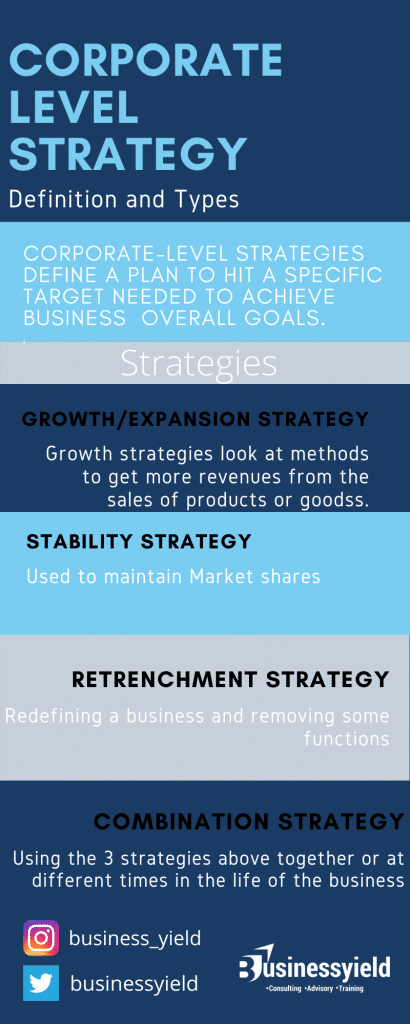Do I tell you a secret? I used the word corporate-level strategies for many years without knowing what it actually meant. Later on, on finding out the meaning, I realized I was using it aright. A miracle right? Join us as we x-ray the concept of corporate-level strategy. It promises to be an interesting one.
What is Corporate Level Strategy?
Business owners need targeted corporate-level strategies to position themselves for success.
Corporate-level strategies define a plan to hit a specific target needed to achieve business goals.
Strategies tend to be long-term in nature but you should have a medium for adjustments, based on uncertainty and changing market conditions.
Let me explain.
Decision making in organizations come under 3 strata of management; the top, middle, and low-level management.
Strategies or what you can call business decisions are made by each of these levels. These strategies are made in 3 different ways by these management levels.
That is to say, strategies can be formulated at three levels, namely, the corporate level, the business level, and the functional level.
At the corporate level, the strategy is formulated for the organization as a whole. In essence, a corporate strategy deals with decisions related to various business areas in which the firm operates and competes. It is when a business makes a decision that affects the whole company.
The decision affects the company’s finances, management, human resources, where the products are sold, just about everything in the company. The purpose of a corporate-level decision is to maximize profitability and maintain financial success in the future.
In addition, this decision is utilized to help increase competitive advantage over competitors and to continue to offer a unique product or service to consumers.
I hope you understood the concept of Corporate level strategy or decision?
Let us now move to the types of corporate-level strategy.
What are the Types of Corporate Level Strategy?
Strategies can come in diverse forms. For the sake of this post, we will discuss the four major types of corporate strategy.
#1. Expansion/Growth Strategy
Every business wishes to grow and occupy a substantial market share if it wants to continue in that niche.
Growth strategies look at methods to get more revenues from the sales of products or goods.
There is a vertical and horizontal strategy when referring to growth strategies. A vertical strategy seeks growth by taking over various components of the operation it usually outsources.
For example, a juice company farming for the fruits it uses. By taking over part of the supply chain, they are able to better control quality and supply needs.
A horizontal growth strategy refers to a business extending its reach of existing products or services to new geographic areas or new target markets.
I hope you know that this horizontal growth strategy can come in the form of niche marketing? That is expansion into other niches or market segments you never were involved in.
Mediums through which a company can expand are; Concentration, Integration, Diversification, Cooperation, and Internationalization. Concentration is done by Market penetration, Market Development, and Product development.
During the growth stage, you can promote it using Advertising. Learn Low-cost Advert Strategies.
#2. Stability Strategy
It is possible for a company to reach its optimal market share goals.
At this point, management might choose a stability strategy to maintain market shares. Methods used to achieve this include making processes more cost-efficient through automation, cutting costs where possible, and negotiating better costs on raw materials.
So, when a company is convinced that it should continue in the existing business and is doing reasonably well in that business but no scope for significant growth, the stability is the strategy to be adopted.
This strategy also requires management to focus on customer retention. This is a popular strategy used during adverse economic periods.
However, there are times when this strategy makes sense for a small business, regardless of the external business environment. You have to figure that out.
If your business operating in the stability strategy, you can Pause/Proceed with caution, make no change or operate with a Profit strategy.
#3. Retrenchment Strategy
Retrenchment strategy may require a firm to redefine its business, abandon some markets or reduce its functions. It may make a firm layoff, reduce R&D or marketing or other outlays, and increase the collection of receivables.
Redefining the business and reducing the pace of activities can improve the performance of a firm. Expansion in combination with Retrenchment is a very common strategy. Retrenchment alone is probably the least frequently used strategy.
Retrenchment strategy involves a partial or total withdrawal either from products, markets or functions in one or more of a firm’s businesses.
This strategy is used during periods of decline and crisis when a business is not thought to bring profitability back to the firm.
Reasons for following retrenchment strategy:
1. The firm is doing poorly, but if it is worth saving, you adopt a turnaround strategy.
2. If there is pressure from various groups of stakeholders to improve performance. You cut the loss-making portion of the business in a divestment strategy.
3. If better opportunities for doing business are available elsewhere a firm can better utilize its strengths. The company can liquidate.
#4. Combination Strategy
Combination strategies are a mix of expansion, stability, or retrenchment strategies applied either at the same time in different businesses or at different times in the same business.
Actually, no organization has grown and survived by following a single strategy.
Normally, businesses require owners to adopt different strategies just to suit different situations.
For instance, as companies divest, they also need to formulate expansion plans that will strengthen the remaining businesses, start new ones or make acquisitions.
An organization following a stability strategy for quite some time has to consider expansion. And one that has been on expansion for long has to pause to sustain his businesses. Multi-business firms have to adopt multiple strategies either simultaneously or sequentially.
The Advantages of Corporate-Level Strategy
Implementing a corporate level plan may appear to be a difficult procedure, especially if you’ve never had one before. However, the benefits of a thorough business plan far outweigh the time and work required to implement the strategy.
Here are five ways that a corporate strategy can help your company:
#1. Enables your company to be proactive
Being behind the curve is one of the worst things you can do for your business. When you are, you must react to everything that happens to you. However, with a good corporate level plan, your company may be proactive rather than reactive.
Your company will be able to predict future events and plan accordingly. In this approach, staying ahead of the curve (being proactive) assists your firm in keeping up with the market and staying ahead of the competition.
#2. Improves Efficiency
A lucrative business is one that is efficient. In addition, a thorough corporate level plan can put your company on the path to greater efficiency in all sectors.
The corporate strategy gives your company a goal to strive for and a road map for how to get there. It demonstrates where you should make changes to achieve your goals and how to make each component of your business run more successfully.
#3. Expands market share
With a focused corporate level strategy, your company will gain significant insight into the plethora of aspects that influence how you do business, such as:
- Consumer groups
- Product selections
- Market developments
- Offerings of services
Controlling these elements gives you knowledge and power that can help you raise your market share like never before.
#4. Boosts Profitability
Profitability follows directly from advances in efficiency and market share. When you execute a corporate level plan, you are putting your company on the path to greater profitability.
It may take some time to achieve the profitability you seek (since you must first address efficiency and market share), but once you do, you’ll realize how valuable (and strong) corporate level planning is to your business.
#5. Increases the long-term viability of your business
Industries and marketplaces are ever-changing. You want your company to be strong enough to withstand any changes that come your way.
A solid corporation level plan serves as a foundation upon which the rest of your company can rely. It provides you with the focus and foresight required to keep your business running smoothly and successfully through the ups and downs of your industry.
When you develop a corporate strategy, you provide your company a clear direction. This might make it much easier to specify the particular steps required for your firm to thrive.
Corporate Level Strategy’s Key Characteristics
#1. In the Long Run
Corporate level strategies are long-term rather than short-term in nature. You can create them quickly, but implementing and completing them will take much longer.
#2. Unsure
Corporate level plans are inherently ambiguous. This is due to the fact that they are incredibly broad and frequently include a large number of moving elements (the success of your departments, the market, your competition, the economy, etc.).
#3. Oriented Towards Overarching Objectives
Corporate level strategy should be aimed toward the overall aims of your firm. Improving your kitchen staff’s performance is not a corporate-level plan. It is, however, a component of a much larger goal (such as increasing consumer perception) that your company is attempting to achieve.
#4. Complicated
Corporate level tactics are naturally more complex because they apply to the entire firm. They will have many moving pieces and may consist of a long list of sub-strategies (both business level and functional level).
#5. Adaptive
Strategies at the corporate level should not be set in stone. You want your company to be able to react to changing consumer needs as well as market and industry developments. To do so, your corporate strategy should be as dynamic as possible.
That doesn’t imply you have to include contingency plans for every possible scenario – that may be an impossible undertaking. Allow your company level plan (and yourself) to adapt in response to the demands of your firm.
Visualize your company as a tree in a storm to better comprehend the importance of a dynamic corporate level strategy. The trees that can bend and shift the most are the ones that survive the storm the longest. They are blown over and collapse to the ground if they do not have that capacity.
A dynamic corporate level strategy makes your company more adaptable in the face of market and industry storms, preventing it from being blown over and collapsing to the ground.
#6. Broad-Reaching
Corporate level strategies, by definition, are far-reaching and will have a positive impact on the entire business – from the owners at the top down to the new employee just starting out. Every department, every executive, every manager, and every employee has a place to focus their efforts as a result of the strategy.
This is useful since business is similar to a tug of war. Your organization is on one side. Your consumers, markets, and the industry as a whole are on the other side. That’s a substantial amount of weight on the other end of the rope.
Upper management pulling in one direction, middle management pulling in another, and your workforce pulling in a whole opposite one would not assist your firm. Corporate strategy brings everyone together and pulls them in the same direction (toward your goals).
#7. Constructed From The Top Down
Corporate strategies are always developed at the top levels of your organization. Owners, board members, and chief executives (e.g., CEO, CFO, COO) should develop strategies and put them into action at all levels of the organization.
However, this does not imply that you should develop your corporate strategy in a vacuum, with only input from other members of high management. Talking to middle management as well as your people in the trenches is the greatest approach to find out what’s really going on in your company. Only then will you be able to devise the most effective corporate-level plan.
Once you’ve determined which corporate level plan is best for your company, the following step is to transform those objectives into business level strategy. Following the development of your business level strategy, the final step is to put those plans into action by executing a functional level strategy.
Conclusion
Corporate-level strategies are directives given by top management who make strategic/longterm decisions.
Don’t shy away from this because you are not a management expert.
In like manner, read slowly and ask questions where you don’t understand.
It is quite easy and can save your business from liquidation. In addition, know the strategy to use at every point in the business’s life.
Be wise!
Corporate Level Strategy FAQ’s
What is corporate level strategy example?
A gas station company buying an oil refinery is one example. Diversification – A corporate strategy in which a corporation acquires or starts a business that is different from its existing offering. Diversification can take place at the business unit or corporate level.
What is the difference between business level and corporate level strategy?
A business-level strategy is for building a customer base and profitably marketing a product. Corporate-level strategy, on the other hand, is used to determine which company divisions to sell and buy, as well as how to integrate activities and discover synergies between them.
Why is corporate-level strategy important to the diversified firm?
Corporate-level strategies assist businesses in selecting new strategic positions that are projected to boost the firm’s worth. Firms utilize corporate-level strategies to increase revenues and profits, but there may be other strategic goals for growth.
- Financial Stability: Best Practices & Every detail you should know
- CORPORATE FINANCE: The Complete Guide (+ free courses)
- Business Strategy: Levels of Business Strategy+10 Best Business Strategy Examples
- Corporate Accounting: Job Description and Salary
- Corporate Strategy: Levels of Corporate Strategy, Jobs With Examples







